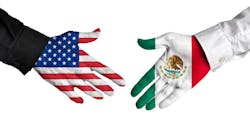Export Advice: Doing Business in Mexico's Automotive Industry
Mexico may surpass India by 2020 as the sixth largest vehicle producer globally, according to the Mexican Association of Automotive Industry. The automotive industry accounts for 18% of Mexico’s manufacturing sector and 3% of its national gross domestic product. Mexico’s auto parts industry is closely tied to its American counterpart and economic growth in the United States. Monica Martínez, commercial specialist, U.S. Embassy in Mexico City, discusses opportunities in the below Q&A. Martinez is part of the U.S. Commercial Service’s worldwide network of 108 offices across the United States and in U.S. embassies and consulates in more than 75 countries that help U.S. companies export.
Q. How does the United States compare with Mexico in the automotive industry?
Martínez: The United States is the second largest light vehicle producer in the world, and while Mexico is the top producer in Latin America, it currently ranks as the seventh largest worldwide. Since the economic crisis in 2009, Mexico’s auto industry has shown steady growth from 2010 to 2015 and is expected to produce more than 5 million vehicles annually by 2020. Now, the Mexican industry’s immediate concern is satisfying the industry requirements for this increased production, including providing more technology, plastic parts, and metal. There are many opportunities for U.S. suppliers, and many are well-positioned to help meet this demand.
Q: How significant is the presence of automotive manufacturers in Mexico?
Martínez: There are currently 10 manufacturers in Mexico, and there will be 11 by the end of 2016. Current original equipment manufacturers (OEMs) include General Motors, FCA (Fiat-Chrysler), Ford, Nissan, Honda, Toyota, Volkswagen, Mazda, and Kia. This manufacturing base produces 42 brands and 500 models in 22 manufacturing plants and has a network of 1,800 dealers.
The new player, Kia, recently started producing vehicles in Pesquería, Nuevo León. Audi will start its Q5 vehicle production in late September 2016 in San José Chiapa, Puebla. In 2019, BMW will begin production at its first auto plant, which is located in San Luís Potosí. Other long-time players, Nissan and Daimler, have a joint venture agreement for Nissan to produce Mercedes and Infiniti vehicles in Mexico, starting in 2017. Toyota is building its first Mexican car plant in Guanajuato (the Tacoma pickup is already being built in Tijuana). Ford recently announced it will build a new plant in San Luíis Potosí to increase its Mexican vehicle production. BAIC, a Chinese brand, recently began selling cars in the Mexican market, and may set up a production facility next year in Mexico to possibly export to the United States and Latin American markets. Also, because there is such a large amount of vehicle production in Mexico, there are also many auto parts suppliers based in Mexico.
Q: What are some opportunities for U.S. automotive firms exporting to Mexico?
Martínez: U.S. exports of new vehicles are limited due to many of the same models also being produced in Mexico. There is no duty applied for U.S.-made vehicles and auto parts imported into Mexico due to the North American Free Trade Agreement. so there are good opportunities for U.S. companies to export to the tier supplier base, and to partner with Mexican distributors that sell parts to OEMs and the aftermarket.
Tier one suppliers sell directly to OEMs, while tier two suppliers sell directly to tier one suppliers, and tier two to tier three, etc. However, sometimes a firm may be a tier one supplier to one company and a tier two supplier to another company, or supply different tier levels with different products lines.
Q: What market opportunities exist for U.S. auto parts suppliers looking to sell to Mexico?
Martínez: According to U.S. Department of Commerce, U.S. auto parts sales to Mexico have grown from $17.5 billion in 2010 to $30 billion in 2015, an increase of more than 70%. Fifty-three percent of all auto parts imports into Mexico were from the United States last year. The Mexican auto parts market is estimated to be $122 billion in 2016. Opportunities include automotive parts sales to OEMs, tier suppliers and the aftermarket. Major Mexican imports of auto parts and their components include: components for harnesses, parts, stamped parts, accessories for bodies, engines, audio and video devices, seats for vehicles, air bags, automatic gearboxes, differential axles, clutches, and tires.
Some prime targets for U.S. auto parts suppliers looking to sell in Mexico are the U.S. auto producers, both directly and through Mexican suppliers. U.S. companies such as Ford, Chrysler and General Motors have a long historical footprint in Mexico and supply relationships with U.S. auto parts manufacturers.
Looking at the aftermarket, Mexico has 32 million vehicles nationwide and more than 50% of them are at least 10 years old. The Mexican market faces more international competition relative to other countries in Asia and Europe; however, the United States is still recognized as a source of quality trusted suppliers, offering a solid advantage versus the international competition.
Q: Looking at selling to OEMs and tier suppliers, what are some trends for successful U.S. supplier partnering?
Martínez: OEMs and tier suppliers in Mexico usually must comply with background checks, certifications, and quality standards. If the U.S. supplier can provide customized solutions, innovative products and show flexibility, then it can do well in Mexico. When dealing with OEM decision makers in Mexico, time is critical, so it’s important for the U.S. supplier to send required information immediately. “Just-in-time delivery” is also an important requirement that OEMs and tier suppliers are looking for in their supply chain logistics.
U.S. companies should have someone on the ground to find out first-hand what is needed by the customer, including possible technical support. For tier suppliers and OEMs, quality is important because products are screened by the OEM, but the price must be competitive as well. In the past, Mexico has been home to primarily inexpensive compact vehicles, but it is now producing premium brands like Audi and BMW. As a result, OEMs now have more requirements for their suppliers.
Mexico has trade agreements with more than 45 countries, helping make its automotive industry even more globally competitive. With entry into force of the Trans-Pacific Partnership, Mexico will gain enhanced access to six new FTA partners: Australia, Brunei, Malaysia, New Zealand, Singapore, and Vietnam. In addition, we are seeing more investments not only from OEMs, but also from top suppliers.
Q. What about quality standards and determining the tier base supply chain?
Martínez: U.S. automotive parts suppliers looking to supply automotive parts to Mexico need to consider where in the supply chain their products, auto parts, or equipment fits, whether it’s tier one base—selling directly to OEMs, or tier two or tier three.
Normally, the OEM won’t deal with the import process, but instead deals with local distributors who can provide engineering and after-sale service. Today, there are more partnering opportunities with tier two suppliers because they are seeking partners that will help them to comply with stricter and more advanced quality certifications. By 2017, tier two suppliers will be required to meet international standards so they are keenly focused on doing all they can to meet this deadline.
Q: How about selling to Mexico’s automotive aftermarket?
Martínez: Given the increased number of brands and models in Mexico, aftermarket distributors have the challenge of supplying more than 8,000 part numbers on average. To be successful, U.S. companies looking for a distributor in Mexico must prioritize competitive pricing, volume discounts, high quality, rapid delivery times, just-in-time and just-in-sequence stock requirements, printed brochures in Mexican Spanish, provisions of samples, and strong advertising and marketing. U.S. suppliers must be prepared to compete in an aftermarket that is heavily price-driven with strong Asian competition.
Many U.S. auto parts suppliers and distributors buy large volumes of used auto parts at competitive prices and look to resell the items to Mexico. However, the importer in Mexico will most likely ask for an auto parts warranty that most U.S. exporters do not provide. Additionally, the market is fairly saturated, and Mexican importers can buy all the used parts they want. Consequently, for U.S. auto parts suppliers, the real export opportunities are in selling new auto parts.
Q: From your experience, what are some common “lessons learned” among U.S. companies exporting into Mexico’s automotive industry?
Martínez: During their first meeting with Mexican OEMs, tier suppliers or aftermarket representatives, U.S. suppliers should maintain an awareness of relevant industry trends, competitive advantages of products they are looking to sell and knowledge of the competition. U.S. firms should have this information ready because first impressions are essential for success in Mexico’s competitive automotive market. As far as relationships are concerned, don't expect the first meeting to result in a deal. U.S. suppliers need to develop a relationship with potential partners in Mexico first before these potential partners will commit to a longer relationship.
Q: How can the U.S. Commercial Service assist U.S. automotive suppliers?
The U.S. Commercial Service’s global network provides export counseling, market intelligence, business matchmaking, and support to U.S. participants in Mexican trade shows, and other customized services. U.S. companies can visit www.export.gov to locate their nearest U.S. Commercial Service office in the United States, U.S. Commercial Service in Mexico, and our Country Commercial Guides.
U.S. companies can also view our latest newsletter about upcoming automotive events worldwide. More information, statistics, and reports on the automotive industry are available on the Office of Transportation and Machinery’s website and 2016 Top Markets Reports for Automotive Parts.
Looking to Export? Exhibit at PAACE Automechanika
U.S. firms should consider exhibiting at PAACE Automechanika in Mexico City, June 14–17, 2017. The event is Mexico’s and Central America’s largest and most important OEM automotive and aftermarket trade show. The U.S. Commercial Service will be providing direct marketing support and assistance to U.S. exhibitors at the U.S.A. Pavilion as they look to connect with international partners. For more information, contact Monica Martínez, [email protected].





